Outline of ProgrammeX
| 5. Web Enterprise Management |
5.2 The Realisation of Web Enterprise Management5.1 The Need for a New Management Approach
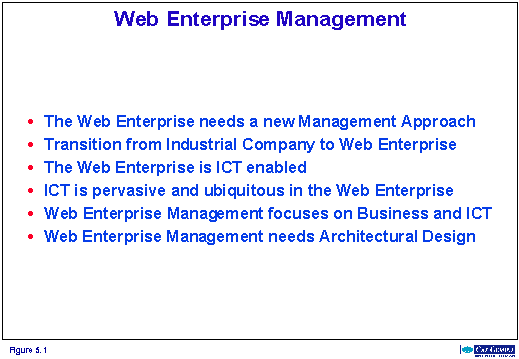
The ICT enabled Web Enterprise needs a new form of integrated management of business and ICT. The transition from industrial companies to Web Enterprises will dramatically change the governance of the company, the management of the business and the operational control of the business processes.
ICT will have a pervasive and ubiquitous character in the Web Enterprise. The management of ICT resources and services must become an integral part of the business management of the Web Enterprise. In the Web Enterprise ICT enabling is not only a necessity for the supply chain management but also for the business management and ICT management in order to realise the agile and adaptive character of the Web Enterprise. Business and ICT management will be an essential part of the integrated Architectural Design of business and ICT.
5.1.1 Transition from Industrial Company to Web Enterprise
The current organisational view on business management is determined by the Industrial Revolution. It is focused on division of labour. Divide and simplify the work and let the workers do not think. The management style is hierarchical. The organisation is aimed at lowest cost per worker and standardised work. The result is a static enterprise.
ICT will fundamentally change the way in which people work together. The result will be that the current large monolithic enterprises gradually transform to Web Enterprises. The Web Enterprise is an ICT enabled association of companies and individuals, which is organised to quickly assemble and disassemble virtual supply chains.
The Web Enterprise links people, competencies, facilities and capabilities of different companies or individual workers, together as though they are one enterprise.
The Web Enterprise shows shifting patterns of affiliations, dynamic assembly of core competencies and the resulting virtual supply chains can take many forms.
The Web Enterprise quickly adapts to changes both internally and externally by changing the patterns of co-operation within the enterprise.
Knowledge is the primary resource in the Web Enterprise. The exchange of information and knowledge supports the learning processes of the employees. The enterprise stimulates the employees to create new knowledge for improvement of products, services, production and delivery.The organisational view of the Web Enterprise is determined by the Information and Communication Revolution: empower the workers, enrich their work, let them make maximum use of their intelligence and let all workers contribute to enterprise learning and creativity. The new management style is participative. The organisation consists of participant individuals and teams managing themselves by constant communication. Quality is everyone's job. The organisation is aimed at the highest value added per worker and constant evolution of the product and the processes. The result is a learning and self-renewing enterprise.
5.1.2 Web Enterprise Management
This new organisational view is only feasible with a new form of corporate management: The Web Enterprise Management.
Web Enterprise Management differs strongly from the current corporate management, which is based on the industrial view. Web Enterprise Management focuses on:
- The collaboration of companies and individuals in virtual supply chains and not single-company operations.
- Agile production of tailored products and not mass-production of uniform products.
- Information and knowledge as the primary economic resource before capital, labour, raw materials and land.
The management and operational control of the business processes in the Web Enterprise is realised by:
- Communication between all the participants in the enterprise about the production and delivery of products and services.
- Control of the processes in the supply chain aimed at flexible patterns of the production and delivery of products tailored to the wishes of the individual customer.
- Resource management: controlling that people with the required competencies and other resources with the required capabilities are available at the right time and the right place in the supply chain.
- Availability of the necessary knowledge and information to execute the business processes.
- The registration of all data necessary to provide information to all stakeholders of the Web Enterprise. This information must realise that operations and results of the Web Enterprise remain transparent and accountable.
Web Enterprise Management is clearly more complex and extensive as the corporate management in a hierarchical organisation. ICT plays a crucial role in the realisation of the Web Enterprise. Communication, control, information and knowledge are the ingredients that support Web Enterprise Management and give the Web Enterprise its agile, adaptive and virtual character. The ICT systems will support:
- the communication in the Enterprise;
- the control of processes;
- the management of resources;
- the provision of knowledge and information;
- the registration of corporate data.
The Web Enterprise is only manageable and feasible as an ICT enabled organisation.
During the transition from industrial company to Web Enterprise, ICT will gradually pervade all business processes and eventually become ubiquitous in the whole Web enterprise.
5.2.1 The View on Business and ICT system
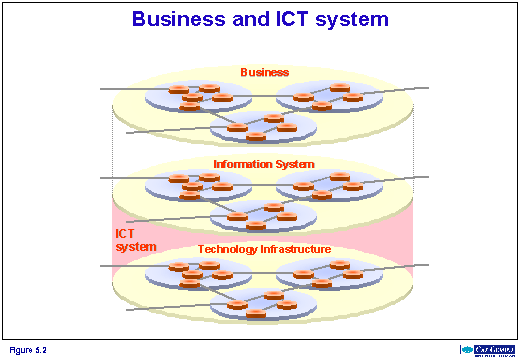
The ICT enabled Web Enterprise results in a "holistic" view on business and ICT system.
In this view the business is a network of communicating and co-operating individuals in the role of employee or customer, and of organisational units such as teams, departments or companies. The business is organised as one or more supply chains of individuals, organisational units and companies working together in delivering products or services to the customers.
In this view the organisation is not a static mechanism performing business processes in a predefined fixed pattern that only allows for the delivery of uniform products and services. The network organisation in the Cap Gemini view acts as a living organism or ecosystem that adapts to its environment. The network organisation is delivering products and services to the customer in a flexible way. This is realised by adapting the pattern of the business processes that are performed in the supply chain.
The ICT system that supports the business is also seen as a network system in two main layers: the information system and the technology infrastructure.
The information system is seen as a network of communicating and co-operating applications (software components).
The applications work together in delivering ICT services to the people in the business of the Web Enterprise. The ICT services enable the business in two ways:
- Support of the people in the business with communication, control, information and knowledge services: people and applications work interactively together in the control and execution of the business process.
- Automation of business processes: the applications themselves control and execute the business process. People have only a supervisory role in monitoring and controlling the behaviour of the applications.
This ICT enabling of a business process may enhance:
- The efficiency: the same business process is performed faster and at lower cost.
- The effectiveness: a new or renewed business process is realised resulting in the delivery of new or renewed products and services to the customers.
These enhancements of the business are the business benefits of the ICT solution.
The technology infrastructure is seen as a network of communicating and co-operating hardware devices and system utility software components. The Technology Infrastructure components work together in delivering technology infrastructure services such as processing, communication and storage capabilities to the software components of the information system.
5.2.2 Web Enterprise Management concerns Business and ICT
The supportive and ubiquitous role of ICT in the management and control of the Web Enterprise results in extreme high requirements for the functionality and the qualities of services delivered by the ICT systems. These services must show the same agile and adaptive character as the Web Enterprise. The ICT systems must support the flexible process patterns and the tailoring of products.
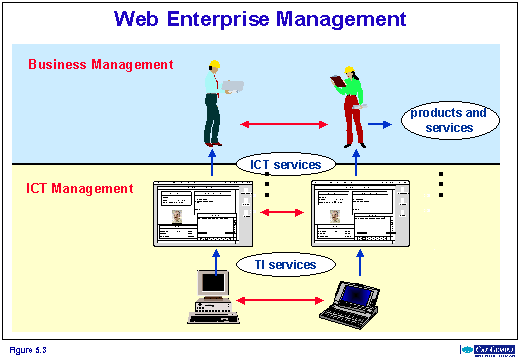
The current approach of systems management is inadequate for ICT systems that must fulfil these new requirements. What is needed is a new form of ICT management, which is an essential and necessary part of the Web Enterprise Management. It is the part of the Web Enterprise Management that focuses on the role of ICT in the business.
The Web Enterprise Management is therefore divided in areas in conformance with our holistic view on Business and ICT system. These are Business Management and ICT Management. ICT Management manages information system and technology infrastructure.
Business Management
The main responsibilities of Business Management are:
- The management of the supply chain of the Web Enterprise with the objective that the products and services that are delivered to the customers have the features and qualities as agreed with the customer.
- The business governance i.e. management of the roles and responsibilities of the participants (companies, business units, people) in the Web Enterprise and the realisation of the accountability of the performances delivered by the individual participants and the enterprise as a whole.
The Web Enterprise will strongly change the governance aspect of corporate management. Questions like "who is in charge?", "who is responsible?" and "who is owner of the resources?" need new answers in the Web Enterprise. Corporate Governance is no longer defined by the boundaries of an individual company and by its hierarchical organisation. The Web Enterprise is only feasible when the roles and responsibilities of the participants are clearly defined. New ways must be found to realise the accountability of all participants from the auditor point of view.
ICT Management
The ICT management in the Web Enterprise has the following aspects:
- ICT Resource Management
Resource management controls that ICT resources (information system and technology infrastructure) with the required capabilities are available at the right time and the right place in the business processes.- ICT Services Management
Services management controls that the ICT resources deliver the services with the required functionality and qualities to the business processes and especially to the people in the Web Enterprise.- ICT Governance
Governance focuses on
- The roles of the ICT resources and the ICT services in the business processes and the accountability of their contribution to the business.
- The roles, responsibilities and accountability of the ICT organisation (employees, external parties) that delivers and develops the ICT services and resources.
ICT Management in the Web Enterprise has not only the responsibility that the ICT resources are available or that the services of the ICT systems fulfil all requirements. ICT Management also governs the role that these ICT services play in the business of the Web Enterprise. This is necessary to fulfil the most important of requirement for ICT in the Web Enterprise: the ICT services must both enable and follow the ever-changing patterns of the business processes and organisation of the Web Enterprise.
5.2.3 Web Enterprise Management is part of Architectural Design
The Web Enterprise Management is part of the architectural design. The management of the Web Enterprise will be the core of the architectural design of business and ICT system. ProgrammeX will develop an actor-based approach for the architectural design of business and ICT system. The approach will primarily focus on the backbone of the Web Enterprise. That is the roles of human resources and ICT resources in the Web Enterprise and how they communicate and collaborate together in delivering products and services to the customer.
5.3 The Changing World of the ICT Organisation and ICT Providers
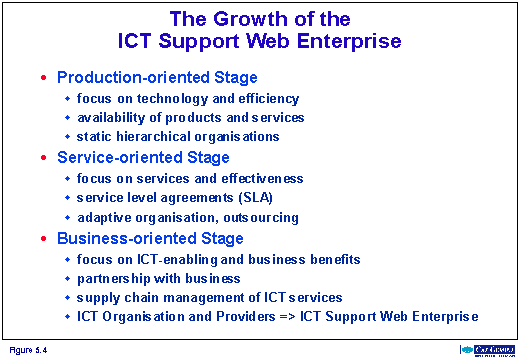
The transition from industrial company to ICT enabled Web Enterprise will fundamentally change the role of the ICT organisation within the company and the role of ICT providers as third parties in the delivery of ICT services to the company.
This development will take place in three stages: the production-oriented, service-oriented and business-oriented stage.
5.3.1 Production-oriented Stage
Most IT organisations within companies came into existence with the introduction of a central information system in the company such as a mainframe system in large companies or a mid-size computer in smaller companies. External IT providers delivered the necessary software and hardware and developed the applications for the company.
The role of the internal IT organisation was the management of the hardware and applications of the central IT system in the company. The main responsibilities of the IT organisation are the availability of the hardware and software resources, the operation of IT systems and the maintenance of existing applications.
Both the external IT providers and the internal IT organisation are organised as a production organisation aimed at the efficient delivery of the IT services or products. The focus is on the technology and the own processes, products and services. IT organisation and IT providers show a typical industrial organisation aimed at lowest cost and standardised services and products. There is a strong technology push. The business must adapt to the technology. The existing IT systems are not very adaptive to changes in the business requirements.
5.3.2 Service-oriented Stage
Currently most IT organisations and IT providers are in the transition from resource-oriented to service-oriented behaviour. The reasons are the growing pace of change in the business and the introduction of new technologies such as PC, LAN, client/server, ERP packages, data warehousing and Internet. The customer is no longer the company but business units in the company with their own IT budgets. In stead of one central information system the internal IT organisation must manage a distributed information system with a lot of computers, networks and a whole variety of applications.
This requires an ICT organisation that
- delivers specific ICT services to specific organisational units and persons in the company
- adapts the ICT services to changing business requirements and new technologies.
The focus shifts from the management of technology and efficient production to the delivery and development of ICT services and their effectiveness for the business.
The service orientation causes a shift from hierarchical to network organisation. The ICT organisation follows on the delivery side the decentralisation of the company. Employees of the ICT organisation fulfil supportive roles in the different business-units.
On the supplier side ICT organisations follow the trend of outsourcing and outsource a part of their tasks to external ICT providers. This is the start of a growing role of the ICT organisation as intermediary between business and external ICT providers.
This is already started with the introduction of Service Level Agreements between the business and the internal ICT organisation and/or external ICT providers. The SLA contains the agreements about the functionality and the qualities of the delivered ICT services. SLA's are not always profitable for the customer. IT organisations that are still in the production-oriented stage use the SLA to reject requests from the customer for services or changes that are outside the scope of the SLA. A good SLA does not fix the functionality of the services but also contains agreements about their adaptation.
The SLA only prescribes what services are delivered and not how the services are delivered. This gives the ICT organisation the opportunity to organise the delivery process in an effective and efficient way and to adapt the delivery and the resources when this useful or necessary. New technology can replace old technology. Changes in resources make it possible to deliver the same service at lower cost or with higher performance.
In many cases companies outsource their whole ICT organisation. This is normally not successful. The SLA with the provider is based on the current status of the ICT services and a production-oriented view of the ICT organisation. Adaptation and growth of the ICT services is not part of the SLA. The company looses a lot of its ICT knowledge and is no longer capable to renegotiate the SLA when new business requirements emerge.
The service orientation leads to a more active role of the ICT organisation in the procurement of new hardware and software resources and the development of new applications. The ICT organisation advises the business about the adaptation of the ICT services to changing business requirements and will co-ordinate the development and implementation of new and renewed services.
5.3.3 Business-oriented Stage
ICT organisations and ICT providers reach this stage when their focus shifts further from the ICT services to the role of these ICT services in the business. The role of ICT as enabler of new and renewed business and the business benefits of the ICT enabling become leading for the definition of the required ICT services and the planning, development and management of ICT resources.
ICT services and ICT resources play roles in the business processes, they even take over responsibilities from people in the business organisation. For the ICT enabling it is important to define which role ICT resources play in the management, control and execution of business processes in the supply chain. This supply chain is no longer restricted to one company. In the transition to the Web Enterprise the role of ICT must be defined for extended supply networks which include more companies.
SLA's will not only define the ICT services but also the role that these services play in the business processes and what business benefits these roles must deliver.
The business orientation leads to a more pro-active role of the ICT organisation. The ICT organisation will actively watch the technology trends and advise the company how the technology can enable the business. The ICT organisation becomes a partner of the business organisation for the design and development of new ICT enabled business.
The business orientation will also shift the role of the ICT providers from technology-oriented to both business and technology oriented. ICT providers must have knowledge of business and ICT for the delivery of ICT enabled business. Business consultants, business architects and business experts will collaborate with ICT consultants, architects and experts in the design and realisation of ICT enabled business.
The ICT organisation will act as intermediary between the business organisation and the consultants, architects, developers and providers that deliver the new ICT enabled business.
The business orientation will cause a further shift to network organisation. The ICT organisation follows the transition to Web Enterprises. The internal ICT organisations of the different companies in the Web Enterprise must collaborate together in the delivery of coherent ICT services that support the agile and adaptive character of the Web Enterprise. The networked ICT systems that support the Web Enterprise will show a large heterogeneity of applications, software and hardware, which all require different business and ICT knowledge and competencies for development and maintenance. This will lead to further outsourcing of supportive and expert roles to external ICT providers and business and ICT professionals.
The co-operation between ICT organisations and the ICT providers will also use ICT enablement to become a Web Enterprise that will show two supply webs. The first supply web will deliver the business and ICT transformations. This supply web supports the planning, design and realisation of the ICT enabled business. The second supply web delivers ICT services and resources to the business. This supply web supports the running of the ICT enabled business.
This new ICT Support Web Enterprise will have an agile and adaptive character and is able to realise and support the ICT enabled Business Web Enterprise.
5.3.4 New Roles for ICT Professionals
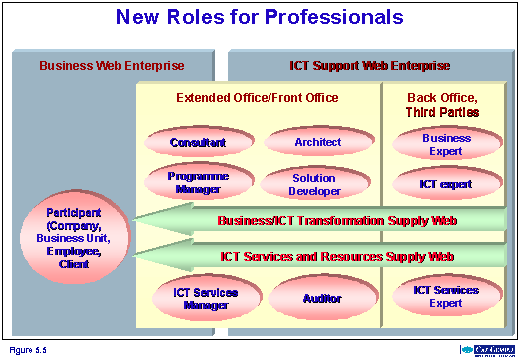
The ICT Support Web Enterprise will result in new roles for the professionals in the development of ICT enabled business and the delivery of ICT services. The whole support organisation will be an ICT enabled Web Enterprise.
An interesting point is the sourcing of the ICT professionals in the ICT Support Web Enterprise. Are they employee of one of the companies within the Business Web Enterprise or employee of and external ICT provider or a free-lancer?
The roles in the ICT Support Web Enterprise are ICT services manager, programme manager, architect, consultant, auditor, solution developer, and expert.
A key role in the ICT Support Web Enterprise is the ICT services manager. The ICT services manager is responsible for:
- management of the ICT services and resources supply web;
- the closing of service level agreements between business and the other ICT professionals and ICT providers;
- the management of the delivery of ICT services to the business;
- the co-ordination of ICT services experts from internal an external parties which perform the delivery of these services;
- the co-ordination with programme managers who are responsible for the design and development of new or renewed ICT enabled business.
The programme manager has a key role in the development of new or renewed ICT enabled business. The programme manager is responsible for the control of a transformation programme of business and ICT and the co-ordination of the different projects in the transformation programme. The programme manager also organises and promotes the co-operation and communication between the members of the different project teams.
Consultants and architects play an important role in the planning and design of new or renewed ICT enabled business and the necessary transformation of business and ICT to realise this business.
Consultants advise on ICT-enabled business solutions and transformation processes. There are consultants with knowledge about the different business aspects of the transformation like business processes or business information and consultants with ICT oriented knowledge like application development and technology infrastructure.
Architects are responsible for the design of the architecture of the new or renewed ICT enabled business. The business and ICT aspects require different knowledge and competencies of the architect. This means that the design is normally not the work of one architect but of a team of architects, who design each an aspect of the ICT enabled business.
Solution developers realise the solutions designed by the architects. The solution developers work in teams, which realise one of the projects within the transformation programme.
The solution may be a business change, a set of applications or a part of the technology infrastructure. The application developers assemble their solutions from application components delivered by component developers in the back-office or by third parties.
The experts support the ICT Support Web Enterprise with specialised knowledge. There are amongst others:
- business experts with specific business knowledge
- ICT experts with knowledge about application design and construction technology infrastructure, security, systems management and software construction.
- ICT services experts with knowledge about monitoring and operating the software and hardware of the ICT system, the installation of software and hardware and end-user support like courses and the helpdesk
- component developers with knowledge about development of components within the component-based development approach.
The ICT enabled Web Enterprise will make the role of the independent auditor even more important. The technology will pervade every business, product and service. Both the business and the applications of the ICT system become more complex. A part of the solution is to extend applications with functionality for diagnosis, testing and auditing. But methods and tools of the auditors must be totally redesigned to meet the complexity of the ICT enabled Web Enterprise.
In the ICT Support Web Enterprise professionals can work at any place and any time and communicate and co-operate with each other via the Internet. In fact when some professionals wants to discuss or create a solution they can use the technology for the creation of a virtual workroom where they work together as in a real room. When during the discussion another expert is needed, he is searched via the network and when he is available, he can join the meeting in the virtual room.
From the Cap Gemini point of view, our architects, consultants and programme managers can work at our office or at the office of the customer. The same holds for solution development teams. Experts work at the office of Cap Gemini or the offices of third parties. They can virtually or physically join the other professionals when their support is needed.
Our ICT services experts also work at our office and use automated tools for remote monitoring, diagnosis, operation of software and hardware, the remote installation of software and the helpdesk function. Only the installation and maintenance of hardware requires experts at location.
The ICT services manager is an employee of the customer organisation or an external ICT service provider such as Cap Gemini. In a Web Enterprise it is possible to have one ICT services manager for the whole enterprise or a team of ICT services managers of different companies.
The ICT Support Web Enterprise requires a lot of flexibility from the professionals, but conversely it offers them also a lot of flexibility. The patterns, in which the professionals co-operate in the delivery of transformations or services to all our customers, are constantly changing. The professional can work at the same time in the delivery of different projects.
But the professional gets a lot of freedom where and when he does his job. The professional can work at the customers premises, using his portable PC as extended office, at home using his home system as home office or at a workstation at the office of Cap Gemini.
5.4 The Changing World of Human Resource Management
The ICT enabled Web Enterprise has consequences for the Human Resource Management both for Cap Gemini and our customers. This paragraph describes the vision of Cap Gemini Interim Management BV on the changing world of human resource management and especially the sourcing of management professionals. In future the same vision will be applicable for all our professionals.
The awareness of the continuous change in business environment, mainly caused by the engine of technology development, puts pressure on our view on organisations, their structure and their competencies. The recognition of the importance of knowledge creation by Nonaka and the consciousness of the individual's ever changing role within organisation by Bridges are merely the consequences of this growing awareness.
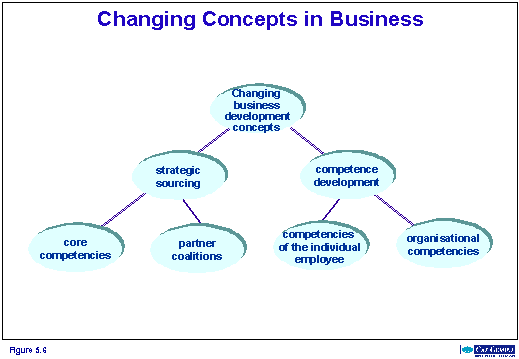
Current concepts for business development, inspired by Hamel, Prahalad, Senge and many others, are mostly based on the focus on strategic sourcing and competence development theories.
They will, no doubt, guide us to:
- the 'virtual organisation',
- 'learning organisation',
- 'fishnet organisation'
- and the 'jobless society'.
All these concepts fit well to the ICT enabled Web Enterprise.
Bridges describes the changing world as follows:
'I believe that the modern world is on the verge of a huge leap in creativity and productivity. But the job is not going to be part of tomorrow's economic reality. Although there will always be enormous amounts of work to do, the work will not be contained in the familiar envelopes we call jobs…'.
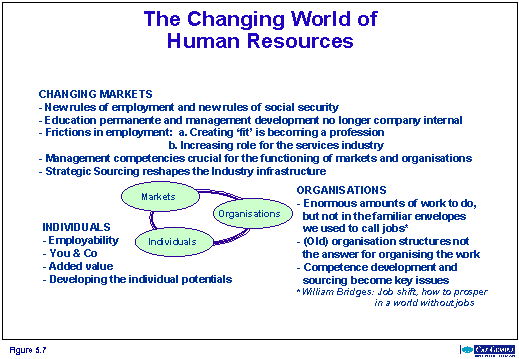
Lifetime employment is a thing of the past. The rules of the labour market and the role of individuals, delivering services within organisations are definitively changing!
So is the importance of management competencies and professionals for the positioning of organisations in their respective markets
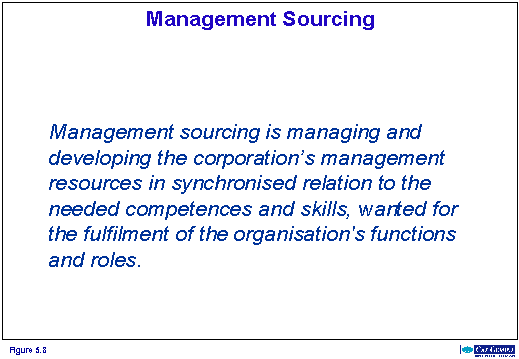
More than ever, the future survival of organisations will depend on the ability to change and adapt themselves to changes in their environment. Innovation can only be realised if the conditions for change are available and the change has been given direction by a deliberate intent. (See Nonaka). Apart from having a strategy for change, a transformation approach and the support of technological skills and expertise, organisations need to dispose of the right managerial skills. Management Sourcing as developed by Cap Gemini Interim Management is therefore a strategic issue for any organisation that wants to be leader in its market.
Although management resources can be hired for the occasion, long term perspective on the development of management competencies will obviously be preferable. This apart from whether the necessary management resources are obtained from a Management Sourcing partnership or else.
The appearances of Management Sourcing differ from industry to industry, with the dynamics of organisational change.
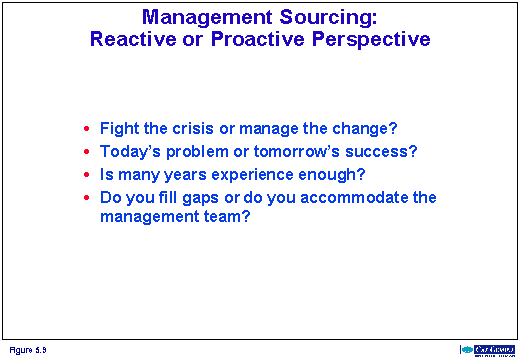
The concept of Management Sourcing includes the former known aspects of:
- Management Recruitment, talent spotting and the loss of management resources;
- Management development, training and education, management assignments, job rotation, coaching, mentoring, intervision, shadow management, management support;
- The management consequences of insourcing and outsourcing alliances;
- Outplacement, Management Search and Interim Management.
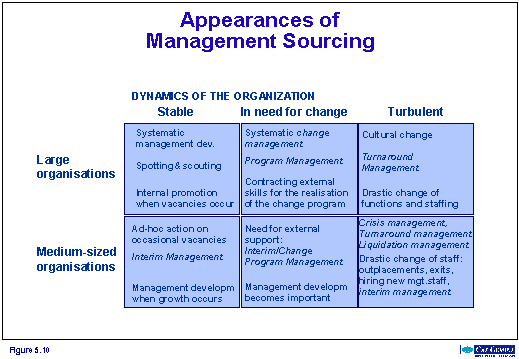
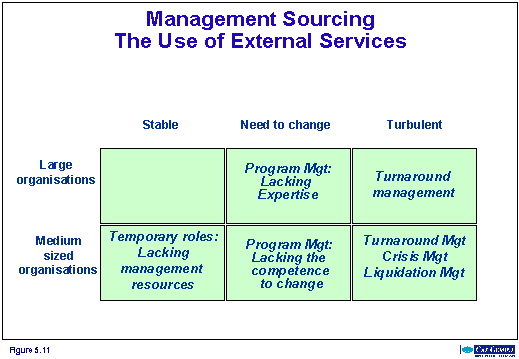
In the decades ahead the employer-employee relation will modify towards a partnership relation. The perfect manager will fulfil temporary roles in line with the needs of the changing organisation. As a consequence of the 'virtual organisation' Management Sourcing will be an obtainable service, delivered by the 'coalitions of human resources' that will derive from today's services companies like Cap Gemini.